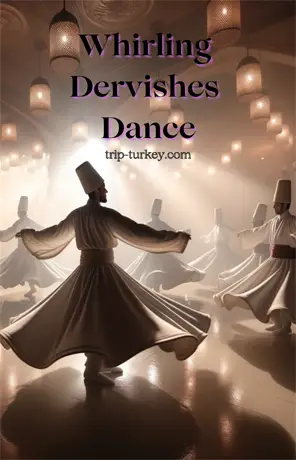Rumi’s Legacy: Sufi Magic & Whirling Dervishes Dance
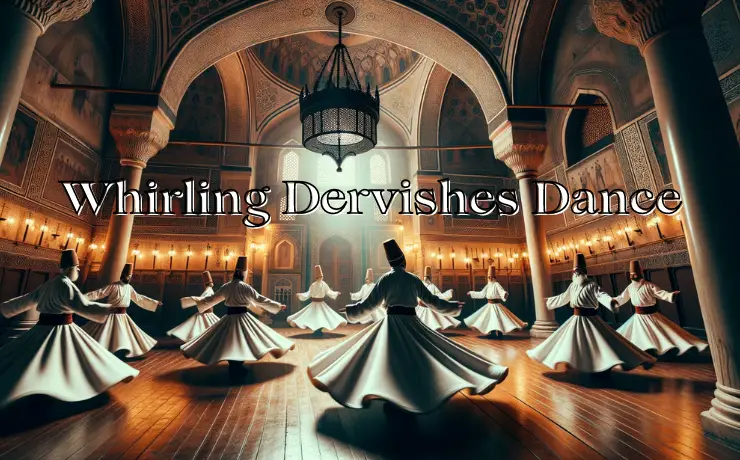
Whirling Dervishes Dance, an entrancing spectacle steeped in mystique and spirituality, beckons the culturally astute and the spiritually curious. As a time-honored Sufi tradition, this dance transcends mere performance, inviting onlookers into a realm of divine ecstasy and meditative trance.
Originating from the teachings of the legendary Rumi, this dance is not only a feast for the eyes but a journey into the soul. Imagine the rhythmic twirls set against haunting Sufi melodies, each turn symbolizing a heavenly reach towards personal and universal harmony. Beyond the captivating swirls lies a story – one of love, devotion, and a relentless search for the truth.
As we traverse this mystical landscape, let’s delve deep into the heart of this unique cultural emblem, exploring its historical roots, philosophical depths, and its undiminished allure in today’s fast-paced world. The Whirling Dervishes Dance is more than a travel checkpoint; it’s an emotive expedition into the profound depths of human experience.
Whirling Dervish Origin
The enigmatic Whirling Dervishes Dance, with its serene dancers spinning endlessly in their flowing white gowns, is more than just an artistic performance; it’s a spiritual journey rooted deeply in Sufi traditions. This dance form, known as the Sema, originated in the 13th century from the teachings of Jalaluddin Rumi, a Persian poet, Islamic jurist, theologian, and Sufi mystic. Rumi founded the Mevlevi Order, often known as the Whirling Dervishes due to their famous practice of whirling as a form of dhikr (remembrance of God).
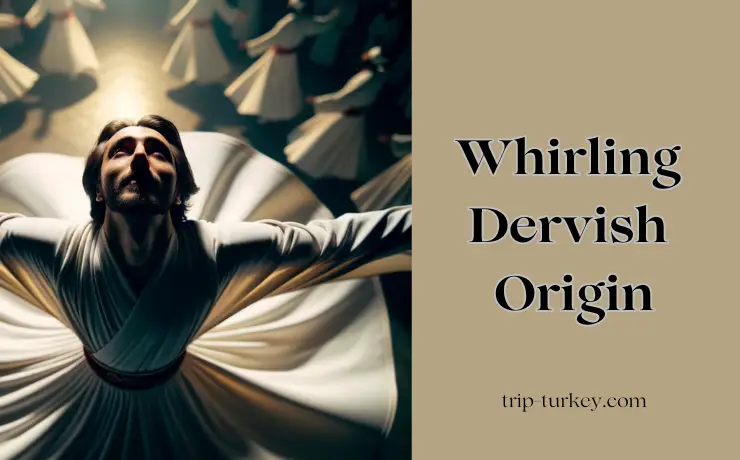
Whirling Dervishes meaning
The Whirling Dervishes meaning transcends simple dance movements. Each aspect of the Sema ceremony symbolizes a mystical journey: an ascent from the earthly to the spiritual, revolving both around the heart and towards truth and love. The dancers, or semazens, start with their arms crossed, symbolizing the unity of God. As they spin, their arms open: the right hand is directed upwards to receive God’s blessings, and the left hand is turned downwards, conveying those blessings to earth.
In terms of choreography, the Whirling Dervishes Dance is unique. Unlike other forms of dance, it does not seek to express a narrative or emotion. Instead, it aims to achieve a state of spiritual ecstasy and connection with the divine. Interestingly, the whirling is not just a random spin; it is a carefully choreographed act symbolizing the revolving of the universe and the cyclical nature of existence.
Furthermore, the attire worn during the Whirling Dervishes Dance is profoundly symbolic. The tall, conical hat (sikke) represents the tombstone of the ego; the white skirt symbolizes the ego’s shroud. As the Dervishes shed their black cloaks and begin whirling, it signifies the rebirth of the soul, freed from the materialism of the world.
This dance, while deeply spiritual, has also gained global recognition as an intangible heritage of humanity by UNESCO, which not only emphasizes its cultural significance but also its role in bridging diverse cultures and promoting peace and harmony. The Whirling Dervishes Dance is a captivating, serene, and profoundly moving experience, deeply rooted in the rich soil of Islamic mysticism, offering a glimpse into the soul’s journey towards an immersive communion with the divine.
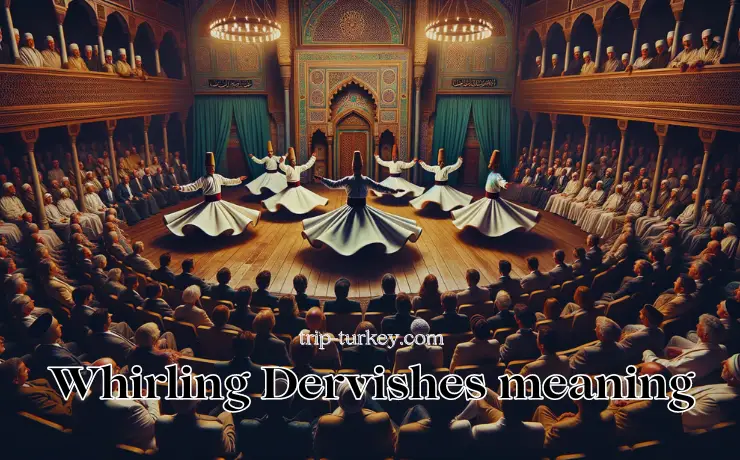
What is the Whirling Dervishes dance?
The Whirling Dervishes dance is a form of physically active meditation that originated among Sufis, which is a mystical Islamic belief system. It’s part of a ceremony called the Sema, a spiritual journey of dervishes (ascetics) who aim to reach divine love and maturity.
Sufi whirling
Emerging in the 13th century from the teachings of the famous Persian poet and Sufi mystic, Rumi, the Whirling Dervishes dance is more than just a cultural spectacle; it represents a sacred ritual where dancers, clad in white robes and tall hats, spin in rhythmic patterns, symbolizing the spiritual ascent to heaven and the journey of the soul. Each aspect of the dance carries symbolic meaning: the dancer’s hat represents the tombstone of the ego; the white skirt, the ego’s shroud.
As the Dervish whirls, one hand points upwards towards divine grace, while the other faces downwards, directing this grace to earth. This dance is a physical manifestation of the spiritual journey to reach perfection, leaving behind the ego to unite with God, characterized by a trance-like state that conveys deep spiritual emotion. While deeply rooted in Islamic culture and Sufi practice, the Whirling Dervishes dance has gained international recognition for its artistic and philosophical depth, resonating with diverse audiences worldwide.
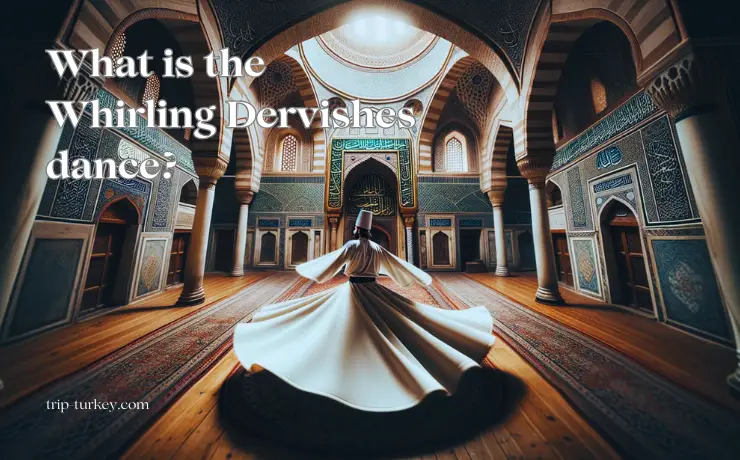
Whirling Dervishes Turkey
Turkey, the birthplace of the Whirling Dervishes, offers several locations where you can witness this captivating dance. The performance is not just a tourist attraction but a ceremonial ritual deeply embedded in Turkish culture and Sufi traditions.
Where to see whirling dervishes in Turkey?
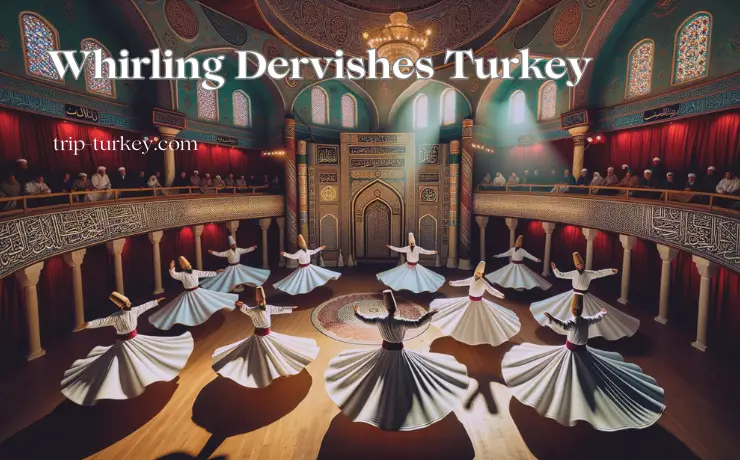
Whirling dervishes Istanbul
Istanbul, the vibrant crossroads of Europe and Asia, hosts some of the most accessible performances for tourists. The Hodjapasha Art and Culture Center, set in a restored 15th-century hammam, is a popular venue where the mystical Sema ceremony can be experienced, blending the rich history of the city with the profound spirituality of the dance.
If you want to join a Mevlevi Sema and the Whirling Dervishes show in Istanbul, you can access Whirling Dervishes Istanbul tickets from here.
Dervish show Istanbul Facts
You should know some basic and important things to know before you attend this whirling show. During the Sirkeci whirling dervishes event, no applause was allowed. Do not talk or take photos as well. Additionally, children under 7 years old are not allowed into the show.
Whirling dervishes Cappadocia
In the unique, ethereal landscapes of Cappadocia, the Sema ceremony takes on an otherworldly charm. The performances are often held in ancient caravanserais, where the historic ambiance adds depth to the spiritual display. Witnessing the dervishes spin in unison amid the region’s fairy-tale-like terrain is truly an unforgettable experience.
You can book for the best whirling dervish show in Cappadocia now.
Whirling Dervish Konya
Konya, the heartland of the Whirling Dervishes, is where this tradition began. It was the home of Rumi, whose teachings inspired the dance. In Konya, visitors can delve into the roots of Sufism, visit Rumi’s mausoleum, and observe the dervishes in a more traditional and spiritual setting, especially in the Mevlana Museum (Whirling Dervish Museum Konya) which used to be a monastery for dervishes.
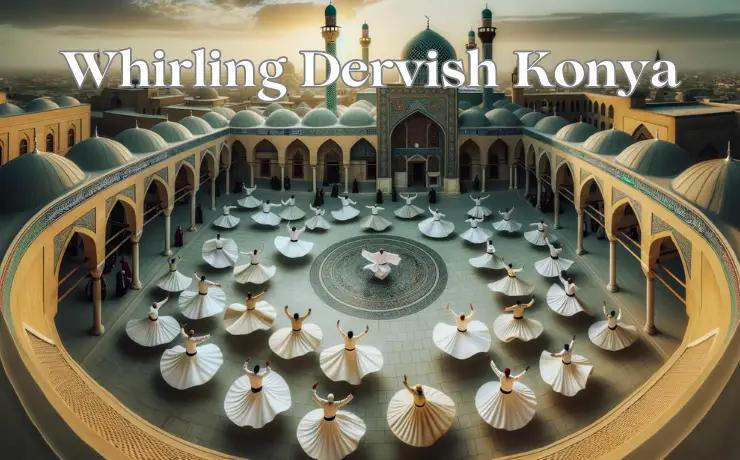
Whirling Dervishes Festival 2023
The Whirling Dervishes Festival, held annually in December in Konya, commemorates the death anniversary of Rumi, known as Şeb-i Arus (The Wedding Night). This festival attracts thousands from around the globe, offering a unique chance to see a large-scale, authentic performance, as well as participate in activities highlighting Sufi culture and Rumi’s teachings.
Each of these destinations offers a unique window into the profound world of the Whirling Dervishes, revealing aspects of Turkish culture, history, and spiritual depth often unseen in the everyday hustle and bustle.
You can get access to Whirling Dervish Konya tickets from here.
Whirling Dervish performance Konya has never been so alive!
In Conclusion
In conclusion, the mesmerizing Whirling Dervishes dance, integral to Turkey’s cultural and spiritual fabric, can be experienced in various key locations across the country. Istanbul provides easily accessible and enchanting performances, particularly in historic venues like the Hodjapasha Art and Culture Center.
For those venturing into the magical landscapes of Cappadocia, the dance takes an ethereal dimension against its ancient, mystical backdrops. The city of Konya offers the most authentic experience, deeply rooted in the tradition’s origins and the teachings of Rumi, especially poignant during the annual Whirling Dervishes Festival in December.
Each of these places, with their unique atmospheres and settings, collectively encapsulate the profound essence and enduring allure of the Whirling Dervishes, marking them as a must-see for anyone seeking to immerse themselves in the rich tapestry of Turkish history and spirituality.
If you want to read a fictional novel about the life of Rumi, “The Forty Rules of Love: A Novel of Rumi” by Elif Shafak could be a heartwarming choice.
Q&A About Whirling Dervishes Dance
Questions about the Whirling Dervishes Dance often delve into its origins with Rumi, the symbolism in its movements and attire, and its spiritual significance. Inquiries also focus on the role of music and where to best witness this mesmerizing ceremony, from Istanbul’s vibrant stages to Konya’s spiritual ambiance. Understanding these aspects reveals the dance’s profound cultural and spiritual depth.
What is the spiritual significance of the Whirling Dervishes dance?
The Whirling Dervishes Dance is steeped in spiritual significance, originating from the Sufi tradition, a mystical branch of Islam. This dance symbolizes the spiritual journey to attain divine love and enlightenment. Each aspect, from the dancer’s revolving movement to their clothing, represents the soul’s transcendence from worldly distractions towards communion with the divine. The dancer’s right-hand points upwards to receive blessings, and the left-hand points downwards, directing these blessings to Earth, embodying a spiritual meditation in motion.
Where can I watch the Whirling Dervishes performance in Turkey?
The Whirling Dervishes can be seen in several locations in Turkey. For tourists in Istanbul, the Hodjapasha Art and Culture Center offers a popular showcase. You can see Whirling Dervishes Istanbul tickets from here.
However, for a more authentic experience, Konya, the birthplace of Rumi and the heart of the Sufi culture is ideal, especially during the annual Whirling Dervishes Festival in December. Cappadocia also hosts these performances in historic settings, adding a unique ambiance. See the offer Cappadocia dervish show tickets.
How do the Whirling Dervishes dance differ in Istanbul and Konya?
While the fundamental spiritual essence of the Whirling Dervishes Dance remains the same, the experience differs between Istanbul and Konya. In Istanbul, the performances are tailored more towards an international audience, blending the spectacle with educational elements. Konya, being Rumi’s resting place and the Sufi tradition’s epicenter, offers a more authentic and spiritual experience, particularly during the December festival, where the dance is part of a larger religious and cultural observance.
Why are they named “whirling dervishes,” and what exactly are they?
A whirling dervish is a member of the Mevlevi order, a Sufi Islamic sect known for its unique practice of whirling as a form of dhikr (remembrance of God). The term “dervish” refers to an Islamic mystical ascetic, and they are called “whirling” dervishes due to their famous spinning movements during the dance, which is part of a spiritual ritual aiming to reach a state of transcendental meditation and union with the divine.
What is the purpose of the whirling dervish dance?
The purpose of the whirling dervish dance, or Sema, is primarily spiritual and symbolic. Practiced by members of the Mevlevi Order, a Sufi Islamic sect, it’s a form of active meditation aiming to reach a state of spiritual ecstasy and closeness to God. The dance symbolizes a mystical journey: the dervish’s spinning represents the rotation of the earth and the cycle of life, seeking to transcend worldly distractions, release the soul, and unite with the divine, symbolizing love and divine worship. The ritual promotes spiritual growth and enlightenment, embodying a physical and metaphysical journey towards divine love and truth.
How long do whirling dervishes spin?
Whirling Dervishes typically spin continuously for about 10 to 15 minutes during the Sema ceremony, though the entire ritual, including prayers and music, can last much longer.
What is a Turkish whirling dervish?
A Turkish whirling dervish is a member of the Mevlevi Order in Turkey, known for performing the Sema ceremony, a spiritual dance involving spinning in a repetitive circle as a form of devotion and meditation, symbolizing a mystical journey towards spiritual transcendence.
Why don’t whirling dervishes get dizzy?
Whirling dervishes typically don’t get dizzy due to extensive training and technique. They gradually acclimate their bodies to spinning, focusing on coordinated breathing and a fixed point during rotation. This practice, along with the physical and mental discipline of Sufi meditation, helps them maintain balance and prevent dizziness, allowing them to focus on the spiritual aspect of the dance.
